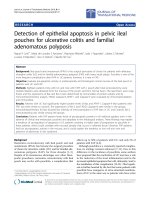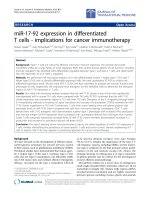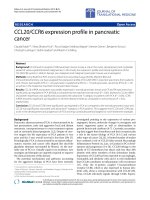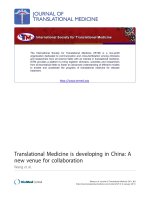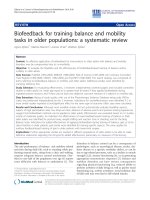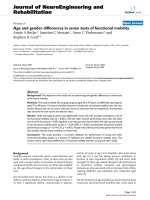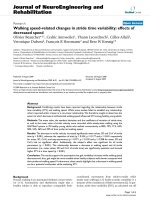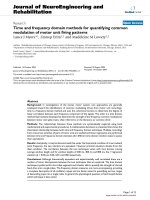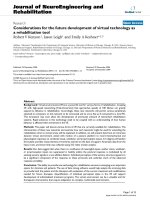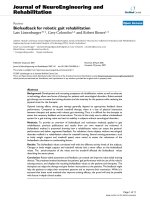báo cáo hóa học:" Time for gender mainstreaming in editorial policies" doc
Bạn đang xem bản rút gọn của tài liệu. Xem và tải ngay bản đầy đủ của tài liệu tại đây (217.5 KB, 4 trang )
EDI T O R I A L Open Access
Time for gender mainstreaming in editorial
policies
Shirin Heidari
1*
, Mirjam J Eckert
1
, Susan Kippax
2
, Quarraisha Abdool Karim
3,4
, Papa Salif Sow
5
, Mark A Wainberg
6
Abstract
The HIV epidemic has been continuously growing among women, and in some parts of the world, HIV-infected
women outnumber men. Women’s greater vulnerability to HIV, both biologically and socially, influences their
health risk and health outcome. This disparity between sexes has been established for other diseases, for example,
autoimmune diseases, malignancies and cardiovascular diseases. Differences in drug effects and treatment
outcomes have also been demonstrated.
Despite proven sex and gender differences, women continue to be underrepresented in clinical trials, and the
absence of gender analyses in published literature is striking. There is a growing advocacy for consideration of
women in research, in particular in the HIV field, and gender mainstreaming of policies is increasingly called for.
However, these efforts have not translated into improved reporting of sex-disaggregated data and provision of
gender analysis in published literature; science editors, as well as publishers, lag behind in this effort.
Instructions for authors issued by journals contain many guidelines for good standards of reporting, and a policy
on sex-disaggregated data and gender analysis should not be amiss here. It is time for editors and publishers to
demonstrate leadership in changing the paradigm in the world of scientific publication. We encourage authors,
peer reviewers and fellow editors to lend their support by taking necessary measures to substantially improve
reporting of gender analysis. Editors’ associations could play an essential role in facilitating a transition to improved
standard editorial policies.
Editorial
The HIV epidemic is increasingly affecting women, and
the proportion of women living with HIV globally has
been continuously on the rise. According to UNAIDS’
latest epidemic update, women constitute slightly more
than half of all people living with HIV. In sub-Saharan
Africa, women bear a disproportionate burden of HIV
infection: nearly 60% of adults living with HIV are
women, and young women, 15 to 24 years of age, are
eight times more likely to b e infected than men in the
same age range. This trend is not restricted to sub-
Saharan Africa. Women living with HIV also outnumber
menintheCaribbean.InAsia,theproportionofHIV
infections in women has been increasing: from 21% in
1990 to 35% in 2009. Similarly, the proportion o f
women with HIV in countries where injecting drug use
has been the main driver of the epidemic has substan-
tially increased [1].
Biological and social differences between men and
women influence health risk and disease progression.
Women appear to be biologically more susceptible to
heterosexual HIV transmission partly due to the large
mucosal surface of the vagina and cervix as potential
viral entry points [2]. Other factors also suggested to
playarolearemicro-abrasion during sex, leve ls of
immunosuppression in the vaginal tract achieved by
seminal fluid, and morphologic al changes during the
hormonal cycle or hormonal fluctuations. In addition,
women can also be exposed through anal sex [3].
For a given CD4 cell count and disease stage [4], it
has been shown that women have a comparatively lower
level of virus, indicating that women may progress at a
lower viral load than men [5]. Further more, women
record higher CD4 cell counts at varying stages, includ-
ing seroconversion, AIDS diagnosis and death from
AIDS-related illnesses [6].
Despite evidence that antiretroviral drugs are equally
effective in women and men, different toxicity profiles
have repeatedly been reported. For example, in a recent
* Correspondence:
1
Journal of the International AIDS Society, 1216 Cointrin, Geneva, Switzerland
Full list of author information is available at the end of the article
Heidari et al. Journal of the International AIDS Society 2011, 14:11
/>© 2011 Heidari et al; licensee BioMed Cent ral Ltd. This is an Open Access article distributed under the terms of the Creative Commons
Attribution License ( which permits unre stricted use, distribution, and reproduction in
any medium, provided the original work is properly cited.
study in Uganda, being female was shown to be asso-
ciated with stavudine-related toxicities [7]. Studies of
pharmacokinetics and pharmacodynamics of antiretro-
viral therapies (ARTs) have noted important variations
between women and men, demonstrating higher plasma
concentration in women as compared with men for sev-
eral drugs, including atazanavir, lopinavir, saquinavir,
nevirapine and efa virenz. Even differences in drug clear-
ance rate have been reported, for example, nevirapine
and saquinavir are shown to have a l ower clearance rate
in women [8-10].
So far, these k nown differences have not translated
into different clinical management, with the exception
of nevirapine, which is not recommended for women
with CD4 cell counts above 250 cells/mm
3
due to a
higher risk of hepatotoxicity [11]. However, clinical
implications of such differences remain to be further
explored, and additional investigations are required to
fully map the sex-based differences in HIV disease pro-
gression, treatment outcome and clinical management.
It is important to note that in addition to physiological
and biological factors, social and behavioural factors play a
fundamental role in a person’s health and in the observed
health disparities between men and women. Women have
an increased vulnerability to HIV because of gender-based
powerrelations:theysufferdomesticandothergender-
based violence, and in gender-subordinate positions,
condom use is difficult, if not impossible, to negotiate
[12,13]. Together with socio-economic disadvantages,
such as illiteracy and poverty, these factors seriously
impede women’s access to testing, counselling, prevention
and treatment programmes.
Gender analysis is essential in demonstrating how
each sex’ s biological processes interact with gender’ s
social roles, socio-economic context, health-seeking
behaviours and access to healthcare systems. Such ana-
lyses are especially important in low-income countries
where gender differenc es in certain populations can
have dramatic effects on life choices and opportunities,
and in subpopulations, such as transgender people, who
are particularly vulnerable.
However, despite proven sex and gender differences,
women continue to be underrepresented in clinical
trials, and gender analyses of data continue to be con-
spicuous by their absence in published literature.
Women have historically been excluded from clinical
trials for a number of reasons. Conc erns about causing
harm to the foetus have often been cited as the primary
reason. However, there are other contributing factors
that have practical implications. Desire to minimize het-
erogeneity in a study population is one. Studies powered
sufficiently to detect differences in subgroups would be
larger, more costly and less feasible (though not impos-
sible). Furthermore, hormonal variations during the
menstrual cycles introduce additional variables that may
complicate the analysis of the effect of a treatment [14].
Disregard of sex-specifi c da ta analysis and generaliza-
tion of research findings from one sex to another result
in interventions that are not firmly based on evidence
for efficacy in women and could potentially lead to sub-
optimal treatment and poorer outcomes. Ensuring parti-
cipation of women and other subpopulations, such as
transgender, in research, including collection and appro-
priate analysis of data, is crucial in drawing accurate
conclusions that can be applied to all subpopulations.
In 1993, following articulated concerns by women’s
health advocates about exclusion of women from clinical
trials, the US National Institutes of Health (NIH) issued
its revitalization act that mandates all NIH-funded clini-
cal trials to include women and minorities in adequate
numbers to be able to identify valid differences, if any,
between sexes and racial subgroups (USA, Public Law
103-43). The authors know of no such law or mandate
in other countries. Despite the effort by the NIH to
ensure rightful participation of subpopulations in trials,
women continue to be underrepresented in clinical
trials. In 2002, a study indicated that only 24% to 25%
of participants in many phase I and II clinical trials in
the United States were women [15]. A more recent
study, in 2006, showed that women remain underrepre-
sented in randomized controlled trials supported by US
federal funding. In 46 clinical studies that included both
male and female participants, women represented, on
average, 37% of the study population and only 24%
when limiting the analysis to drug trials [16].
In recent years, there has been an emergence of initia-
tives that advocate for gender mainstreaming in health
and life science research, in particular in the HIV field.
The UNAIDS initiative, “MakeHIVTrialsWorkfor
Women and Adolescent Girls” , highlights the impor-
tance of establishing a “new norm” of research, where
women and adolescent girls are included in drug inter-
vention studies. In addition, data disaggregated by sex
and also age are key to this initiative as different factors
over a women’s lifespan need to be considered [17].
Resources that compile important information and
make access to knowledge more widely available are
gaining momentum. One such resource can be found
on the website, ,
which “provides strategies and evidence on a full range
of gender-sensitive programming for women and girls”.
In 2010, on the occasion of International Women’s Day,
the International AIDS Society, jointly with 15 other orga-
nizations, including UN agencies, civil society partners and
pharmaceutical companies, released a Consensus State-
ment, “ASKING THE RIGHT QUESTIONS: Advancing
an HIV Research Agenda for Women and Children” .
The Consensus Statement highlighted 20 research
Heidari et al. Journal of the International AIDS Society 2011, 14:11
/>Page 2 of 4
recommendations, calling for increased investments and
efforts to fill these gaps. The statement called in particular
for research data “to be disaggregated by sex to ensure
opportunities for gender- based analysis using a variety of
indicators, such as retention in ART programmes, morbid-
ity and mortality, loss to follow-up, and pharmacokinetic
and pharmacodynamic parameters” [18].
On the occasion of Internation al Women’s Day 2011,
we would like to encourage these efforts to be exten ded
to the world of scientific publishing. Despite increa sed
efforts and advocacy to include women and girls in clin-
ical trials, provision of sex-disaggregated data and gen-
der analysis in most published literature is rare and
often an exception to the rule. Geller et al showed that
87% of studies of randomized clinical trials published in
nine influential medical journals in 2004 “did not report
any outcome by sex or include sex as a covariate in
modelling” [16]. There is little evidence that the trend
has changed since then.
Increasing the involvement o f women, and improving
the provision of gender analysis remains an urgent health
and women ’s rights priority. Collection, analysis and
reporting of sex-disaggregated data are paramount in
ensuring that women and men have equal opportun ities
to participate an d enjoy the highest attainable standards
of physical and mental health; this is one of the funda-
mental human rights, as recognised in the Universal
Declaration of Human Rights and International Covenant
on Economic, Social and Cultural Rights.
Investigators, ethical review boards, funding bodies,
pharmaceutical industry, regulators, peer re viewers and
journal editors shoul d play an active and leadi ng role in
a broad range of aspects, from study design to guide-
lines and recommendations.
It is imperative that editors and publisher show bold
leadership in changing the paradigm in the world of
scientific publishing. Instructions for authors issued by
journals contain many guidelines for good standards of
reporting, and a policy on sex-disaggregated data and
gen der analysis should not be amiss here. It is encoura-
ging to see high-profile journals take up this cause, such
as Nature raising this issue in June 2010 [19], although
concrete actions in t his direction through formal
requirements in editorial policies have yet to be realized.
The Journal of the International AIDS Society is proud
to take a first step in this direction and feature such a
policy on its website ( />about/) encouraging our authors to consider sex and
gender differences in their study designs and requiring
that gender analysis is presented in submitted manu-
scripts where applicable. Inclusion of this section in our
journal’ s instructions for authors i s currently under
negotiation with the publisher. We welcome peer
reviewers in lending their support by ensuring that the
aspect of gender is included in their overall assessments
of a manuscript and highlighting the absence of it when
necessary.
We call on fellow editors and publishers to take
appropriate measures to improve the reporting of sex-
based analyses in peer-reviewed publications. Editors’
associations play an essential role in continuously striv-
ing to improve standard editorial policies, and should
follow suit. Joint effort is necessary to ensure that
women, just as much as men, reap the fruits of research.
Acknowledgements
We would like to thank Leah Goldberg and Cate Harding, interns with the
Journal of the International AIDS Society, who provided valuable support in
researching, reviewing and summarizing the literature on gender differences
in health and women’s inclusion in clinical trials.
Author details
1
Journal of the International AIDS Society, 1216 Cointrin, Geneva,
Switzerland.
2
Social Policy Research Centre, University of New South Wales,
Sydney, Australia.
3
Centre for the AIDS Programme of Research in South
Africa, Nelson R Mandela School of Medicine, University of KwaZulu-Natal,
Durban, South Africa.
4
Department of Epidemiology, Columbia University,
New York, New York, USA.
5
Department of Infectious Diseases, University of
Dakar, BP 5005, Senegal.
6
McGill University AIDS Centre, Jewish General
Hospital, Montreal, Quebec, Canada.
Authors’ contributions
SH wrote the first draft of the article. SK, QAK, MAW, PPS and MJE provided
critical comments and edited the article. All authors read and approved the
final manuscript
Competing interests
SH is an employee of the International AIDS Society, and her salary is
provided partly by unrestricted educational grants from the following
pharmaceutical companies: Abbott, Boehringer Ingelheim, Gilead, Merck,
Pfizer, Roche, Tibotec and ViiV Healthcare. MJE, SK, QAK, MAW and PSS have
no competing interests to declare.
Received: 1 March 2011 Accepted: 8 March 2011
Published: 8 March 2011
References
1. UNAIDS: Global Report [ />htm].
2. Hladik F, Hope TJ: HIV infection of the genital mucosa in women. Curr
HIV/AIDS Rep 2009, 6:20-28.
3. Marlink R, Kao H, Hsieh E: Clinical care issues for women living with HIV
and AIDS in the United States. AIDS Res Hum Retroviruses 2001, 17:1-33.
4. Sterling TR, Vlahov D, Astemborski J, Hoover DR, Margolick JB, Quinn TC:
Initial plasma HIV-1 RNA levels and progression to AIDS in women and
men. N Engl J Med 2001, 344:720-725.
5. Napravnik S, Poole C, Thomas JC, Eron JJ Jr: Gender difference in HIV RNA
levels: a meta-analysis of published studies. J Acquir Immune Defic Syndr
2002, 31:11-19.
6. Prins M, Robertson JR, Brettle RP, Aguado IH, Broers B, Boufassa F,
Goldberg DJ, Zangerle R, Coutinho RA, van den Hoek A: Do gender
differences in CD4 cell counts matter? AIDS 1999, 13:2361-2364.
7. Castelnuovo B, Kiragga A, Kamya MR, Manabe Y: Stavudine toxicity in
women is the main reason for treatment change in a 3-year prospective
cohort of adult patients started on first-line antiretroviral treatment in
Uganda. J Acquir Immune Defic Syndr 2011, 56:59-63.
8. Umeh OC, Currier JS: Sex differences in pharmacokinetics and toxicity of
antiretroviral therapy. Expert Opin Drug Metab Toxicol 2006, 2:273-283.
9. Clark RA, Squires KE: Gender-specific considerations in the antiretroviral
management of HIV-infected women. Expert Rev Anti Infect Ther 2005,
3:213-227.
Heidari et al. Journal of the International AIDS Society 2011, 14:11
/>Page 3 of 4
10. Burger D, van der Heiden I, la Porte C, van der Ende M, Groeneveld P,
Richter C, Koopmans P, Kroon F, Sprenger H, Lindemans J, Schenk P, van
Schaik R: Interpatient variability in the pharmacokinetics of the HIV non-
nucleoside reverse transcriptase inhibitor efavirenz: the effect of gender,
race, and CYP2B6 polymorphism. Br J Clin Pharmacol 2006, 61:148-154.
11. Boehringer Ingelheim: Clarification of risk factors for severe, life-threatening
and fatal hepatotoxicity with VIRAMUNE (nevirapine) [Letter to healthcare
professionals] Ridgefield: Boehringer Ingelheim; 2004.
12. Jewkes R: HIV/AIDS. Gender inequities must be addressed in HIV
prevention. Science 2010, 329:145-147.
13. Jewkes R, Morrell R: Gender and sexuality: emerging perspectives from
the heterosexual epidemic in South Africa and implications for HIV risk
and prevention. J Int AIDS Soc 2010, 13:6.
14. Berlin JA, Ellenberg SS: Inclusion of women in clinical trials. BMC Med
2009, 7:56.
15. Pinnow E, Sharma P, Parekh A, Gevorkian N, Uhl K: Increasing participation
of women in early phase clinical trials approved by the FDA. Womens
Health Issues 2009, 19:89-93.
16. Geller SE, Adams MG, Carnes M: Adherence to federal guidelines for
reporting of sex and race/ethnicity in clinical trials. J Womens Health
2006, 15:1123-1131.
17. UNAIDS: UNAIDS Executive summary and recommendations from the UNAIDS/
GCWA/ICRW/Tibotec expert group consultation on ‘Making HIV Trials Work for
Women and Adolescent Girls’ Geneva: UNAIDS; 2007.
18. Consensus Statement. ASKING THE RIGHT QUESTIONS: Advancing an HIV
Research Agenda for Women and Children Geneva: International AIDS
Society; 2010.
19. Putting gender on the agenda [Editorial]. Nature 2010, 465:665.
doi:10.1186/1758-2652-14-11
Cite this article as: Heidari et al.: Time for gender mainstreaming in
editorial policies. Journal of the International AIDS Society 2011 14:11.
Submit your next manuscript to BioMed Central
and take full advantage of:
• Convenient online submission
• Thorough peer review
• No space constraints or color figure charges
• Immediate publication on acceptance
• Inclusion in PubMed, CAS, Scopus and Google Scholar
• Research which is freely available for redistribution
Submit your manuscript at
www.biomedcentral.com/submit
Heidari et al. Journal of the International AIDS Society 2011, 14:11
/>Page 4 of 4
